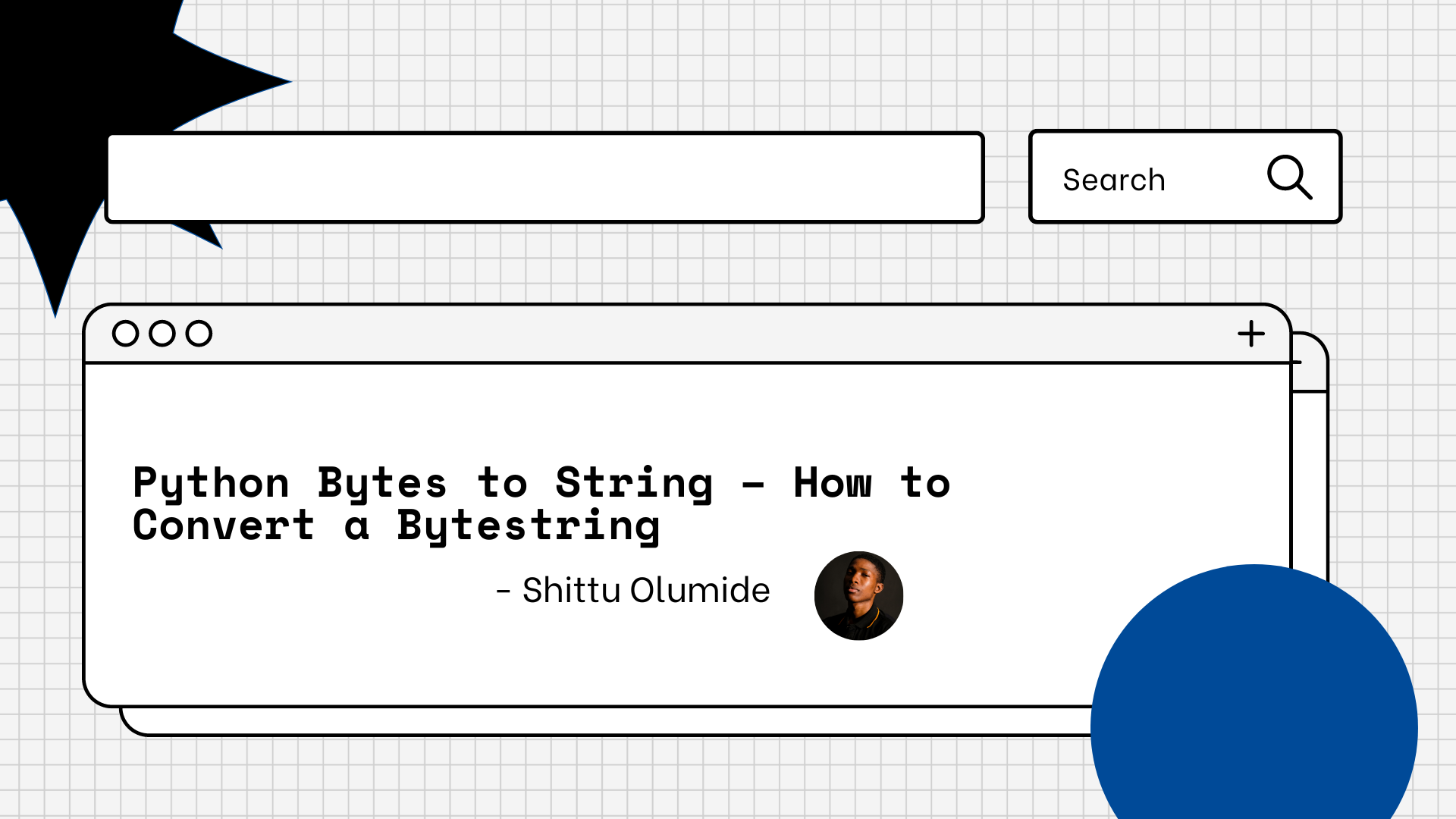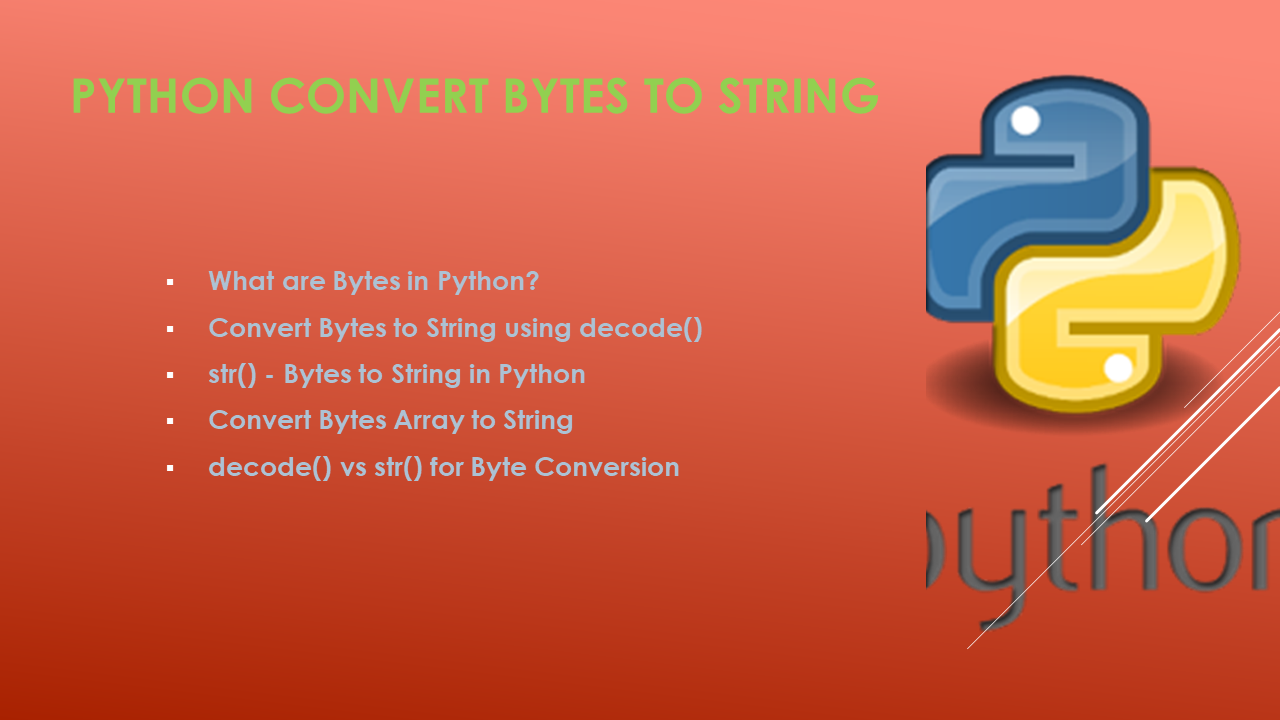Python 3 Bytes to String Conversion Guide
Learn how to effortlessly convert bytes to strings in Python 3 with our comprehensive guide, covering different methods and common use cases.
Learn how to effortlessly convert bytes to strings in Python 3 with our comprehensive guide, covering different methods and common use cases.
In this article, we will explore how to convert between bytes and strings in Python. We will cover the decode() and encode() methods, which are used to convert bytes objects to strings and vice versa, respectively. Additionally, we will discuss the importance of specifying the correct encoding when performing these conversions and the potential consequences of using the wrong encoding.
In Python, you can convert a bytes object to a string using the decode() method. This method takes the encoding of the bytes object as an argument and returns the corresponding string. For example, if you have a bytes object b"abcde" that is encoded in UTF-8, you can convert it to a string using the following code:
b"abcde".decode("utf-8")This will return the string 'abcde'.
It's important to specify the correct encoding when converting bytes to strings. If you don't specify an encoding, Python will use the default encoding, which is usually UTF-8. However, if the bytes object is not encoded in UTF-8, this will result in an error.
You can also convert a string to a bytes object using the encode() method. This method takes the encoding of the string as an argument and returns the corresponding bytes object. For example, if you have a string 'abcde' that you want to encode in UTF-8, you can use the following code:
'abcde'.encode("utf-8")This will return the bytes object b'abcde'.
Again, it's important to specify the correct encoding when converting strings to bytes. If you don't specify an encoding, Python will use the default encoding, which is usually UTF-8.
This Python code demonstrates encoding and decoding strings and bytes. It first decodes a byte string into a string using UTF-8 encoding. Then, it encodes a string into a byte string using UTF-8 encoding. Finally, it demonstrates decoding a byte string encoded in Latin-1 using the appropriate encoding. The code highlights the importance of using the correct encoding for accurate conversion between strings and bytes.
# Define a bytes object
byte_string = b"Hello, world!"
# Decode the bytes object using UTF-8 encoding
decoded_string = byte_string.decode("utf-8")
# Print the decoded string
print(f"Decoded string: {decoded_string}")
# Define a string
text_string = "This is a test string."
# Encode the string using UTF-8 encoding
encoded_bytes = text_string.encode("utf-8")
# Print the encoded bytes
print(f"Encoded bytes: {encoded_bytes}")
# Example with a different encoding (Latin-1)
latin1_bytes = b"\xc5\xd6\xe4\xf6"
# Decode using Latin-1 encoding
decoded_latin1 = latin1_bytes.decode("latin-1")
print(f"Decoded Latin-1 string: {decoded_latin1}")This code demonstrates:
b"Hello, world!" using the decode() method with the "utf-8" encoding."This is a test string." using the encode() method with the "utf-8" encoding.This example highlights the core concepts of encoding and decoding between bytes and strings in Python, emphasizing the importance of using the correct encoding for accurate conversion.
UnicodeDecodeError and UnicodeEncodeError exceptions that can occur during decoding and encoding, respectively. Explain how to handle these errors gracefully using try-except blocks and the errors argument in decode() and encode(). For example, the errors='ignore' argument can be used to skip over characters that cannot be decoded or encoded.bytearray type, which is a mutable sequence of bytes. Explain how it differs from the immutable bytes type and when you might choose one over the other. For example, bytearray is useful when you need to modify binary data in-place.| Conversion | Method | Input | Output | Encoding Argument |
|---|---|---|---|---|
| Bytes to String | decode() |
Bytes object (e.g., b"abcde") |
String (e.g., "abcde") |
Required (e.g., "utf-8") |
| String to Bytes | encode() |
String (e.g., "abcde") |
Bytes object (e.g., b'abcde') |
Required (e.g., "utf-8") |
Key Points:
Understanding how to convert between bytes and strings is fundamental for working with different data formats in Python. By using the decode() and encode() methods with the correct encoding, you can ensure that data is interpreted accurately and avoid potential errors. Remember that bytes and strings are distinct types in Python 3, and choosing the appropriate conversion method is crucial for tasks like file handling, network communication, and cryptography. When working with bytes and strings, always prioritize using the correct encoding to ensure data integrity and prevent unexpected issues in your Python programs.
 Python Bytes to String – How to Convert a Bytestring | By Shittu Olumide In this article, you will learn how to convert a bytestring. I know the word bytestring might sound technical and difficult to understand. But trust me – we will break the process down and understand everything about bytestrings bef...
Python Bytes to String – How to Convert a Bytestring | By Shittu Olumide In this article, you will learn how to convert a bytestring. I know the word bytestring might sound technical and difficult to understand. But trust me – we will break the process down and understand everything about bytestrings bef... How to Convert Bytes to String in Python ? - GeeksforGeeks | A Computer Science portal for geeks. It contains well written, well thought and well explained computer science and programming articles, quizzes and practice/competitive programming/company interview Questions.
How to Convert Bytes to String in Python ? - GeeksforGeeks | A Computer Science portal for geeks. It contains well written, well thought and well explained computer science and programming articles, quizzes and practice/competitive programming/company interview Questions. Converting integer to byte string problem in python 3 - Python Help ... | I have a library function that is failing because I cannot seem to properly convert an integer to a proper byte string except by using a literal. Can someone explain why I get 3 different results from 3 different ways to convert an integer to a byte string? Using a literal, which is the only way the library call works produces this: >>> print(b'1') b'1' Using the builtin bytes function, which the library call rejects, is really strange: >>> i=1 >>> print(bytes(i)) b'\x00' Finally using the...
Converting integer to byte string problem in python 3 - Python Help ... | I have a library function that is failing because I cannot seem to properly convert an integer to a proper byte string except by using a literal. Can someone explain why I get 3 different results from 3 different ways to convert an integer to a byte string? Using a literal, which is the only way the library call works produces this: >>> print(b'1') b'1' Using the builtin bytes function, which the library call rejects, is really strange: >>> i=1 >>> print(bytes(i)) b'\x00' Finally using the... Built-in Types — Python 3.12.7 documentation | The following sections describe the standard types that are built into the interpreter. The principal built-in types are numerics, sequences, mappings, classes, instances and exceptions. Some colle...
Built-in Types — Python 3.12.7 documentation | The following sections describe the standard types that are built into the interpreter. The principal built-in types are numerics, sequences, mappings, classes, instances and exceptions. Some colle... Alliow
Alliow bytes(mystring) without specifying the encoding - Ideas ... | Currently, calling bytes on a str object without specifying an encoding raises a TypeError: >>> bytes("hello") Traceback (most recent call last): File "", line 1, in TypeError: string argument without an encoding In contrast, calling the .encode method on a str object without specifying an encoding assumes UTF-8 by default: >>> "hello".encode() b'hello' For consistency, I would suggest that calling bytes on a str object without an encoding also assumes UTF-8 by default, as ...
 Python Convert Bytes to String - Spark By {Examples} | You can convert bytes to strings very easily in Python by using the decode() or str() function. Bytes and strings are two data types and they play a
Python Convert Bytes to String - Spark By {Examples} | You can convert bytes to strings very easily in Python by using the decode() or str() function. Bytes and strings are two data types and they play a Python Bytes to String Conversion Guide (With Examples) | Ever found yourself needing to convert bytes to a string in Python? In Python, bytes and strings are separate data types that often require conversion from
Python Bytes to String Conversion Guide (With Examples) | Ever found yourself needing to convert bytes to a string in Python? In Python, bytes and strings are separate data types that often require conversion from 3 Simple Ways to Convert Bytes to String in Python - Analytics Vidhya | Ways to convert bytes to strings in Python, essential for data manipulatio:. Decode(), str() constructor, and codecs module explored.
3 Simple Ways to Convert Bytes to String in Python - Analytics Vidhya | Ways to convert bytes to strings in Python, essential for data manipulatio:. Decode(), str() constructor, and codecs module explored.